Morning glory kvamoklit: description, planting and care

The adjoining territory belonging to private households, as well as public places, is often decorated with flowering ornamental plants. These crops include the morning glory kvamoklit, which stands out for its beautiful flowering, as well as the ability to create hedges thanks to branching shoots.

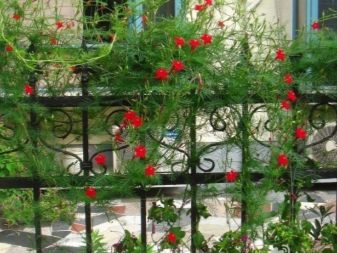
Peculiarities
Morning glory kvamoklit belongs to the genus of the same name of tropical perennials from the bindweed family. The culture is appreciated by gardeners for the ability of plant shoots to decorate and plant greenery not only in gardens, but also to serve as a flowering decor for decorating arches, gazebos and even balconies and loggias. Liana is actively developing and braids any vertical supports well. Ipomoea can be grown as an annual plant in the garden - even in one season, the plant can grow up to three or more meters in length.
Besides the botanical name, the culture has several more names that gardeners use. So, the blooming liana is called "the mantle", "the vines of the cardinal", as well as the "morning star of glory." In its natural environment, morning glory kvamoklite grows in Mexico, as well as in the tropical forests of South and Central America.
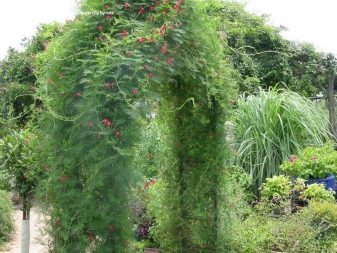

The culture is distinguished by the peculiarity of its stems to actively curl, therefore, in the process of growth, they perfectly twist around any support. As a rule, kvamoklite reaches 3-5 meters in length. The green mass of a tropical perennial stands out for its external attractiveness. The leaves are heart-shaped, divided into many thin segments, making the crop look like a coniferous plant.
In the flowering phase, buds are formed on the liana, consisting of five petals and an elongated corolla. It should be noted that flowers bloom only during daylight hours, and in the evening the buds close, forming colored tubes in the beautiful green foliage.
Certain varieties of kvamoklite can close their flowers from excess ultraviolet radiation even during the day.


As a rule, the liana blooms at the end of summer, and after that, seed pods are formed on the culture, each of which contains 4 seeds. In light of the peculiarities of the Russian climate, morning glory kvamoklite in the open field is most often cultivated as an annual, however, in places with mild winters, the vine can be successfully grown for several years.


Varieties
In the subgenus of tropical liana, there are four main species that are actively cultivated for decorative purposes in the open field.
Qumoclit coccinea
The shoots of the culture reach a height of three meters. The stems are distinguished by their fleshiness and rapid growth. The leaves of red kvamoklite are divided into three parts, the length of each varies from 5 to 10 centimeters, depending on the age of the plant. Liana is prized by gardeners for its incredibly beautiful flowering. The buds of the culture are shaped like a star with a funnel-shaped corolla. The petals can be carmine or red-orange.
Ipomoea subspecies is capable of blooming with whole inflorescences or separately growing buds. In the first case, a group of flowers will consist of 3–8 buds. The plant blooms much earlier than the rest of the subgenus, as a rule, the flowering phase occurs in July; at the same time, the flowers on the liana remain fresh for one month.
You can find ivy-shaped kvamoklite, kvamoklite "Fiery cardinal".

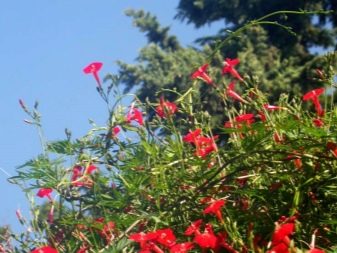
Quamoclit lobada
In the wild, this type of quamoclite is found only in certain areas of South America. The main stem of the liana is painted in a purple-bronze color, the side shoots will be painted in a darker shade. As they mature and elongate, the climbing parts of the culture gradually turn green. Flowers of lobed kvamoklite can have a mixture of colors even on one inflorescence. The degree of contrast will directly depend on the maturation of the bud.
When closed, flower petals can be crimson or pink, the flower itself can resemble the shape of a drop. As the petals open, they brighten, acquiring beige shades. The flowering phase of the liana falls on August - September.


Quamoclit pinnata
In its subgenus, the culture stands out for its impressive size: the plant can have shoots, the length of which will be 4–5 meters. Liana is most often grown as a garden annual. Cirrus kvamoklite owes its name to leaves, which will have dozens of filamentous blades. The external features of the structure of the leaf make it possible to call the culture "cypress liana".
The plant blooms with small funnel-shaped flowers, the petals of which can be pink, red or white. This crop is very often used as a mother plant for producing climbing hybrid varieties.
Kvamoklit "Twinkling Stars" is the most demanded variety of all plants of the feathery subgenus of tropical lianas, which is a mixture of seeds of crops with different colors of flowers in one package.


Quamoclit Sloteri
A popular hybrid annual with expressive leaves containing filamentous blades. The culture enters the flowering phase by mid-summer, it blooms with scarlet flowers with a whitish throat. Liana grows small, as a rule, its length reaches a maximum of one and a half meters.
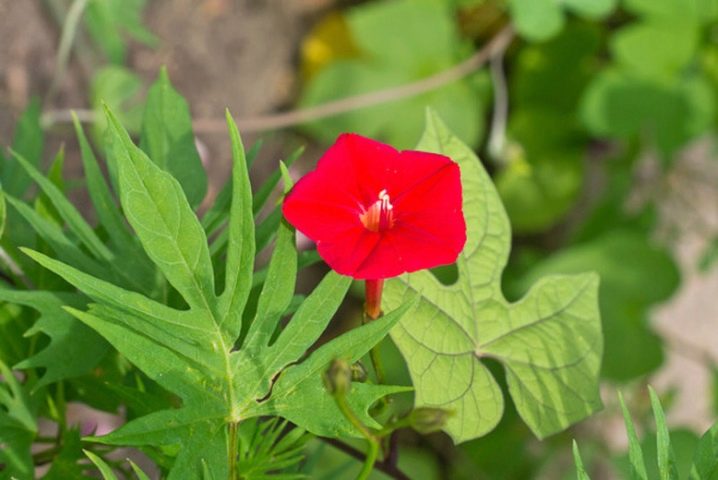
Sowing seeds
Morning glory kvamoklit is distinguished by its ability to reproduce in various ways, which, subject to all conditions, give positive results. However, the simplest option is planting crop seeds. Typically, gardeners collect seeds from a plant after flowering - in the fall, it is not possible to sow them right away, in all varieties of kvamoklite the seed material retains its viability for a very long time.

As the practice of growing garden creepers shows, it is not necessary to germinate seeds in separate containers, since the plant tolerates transplanting very badly. The collected material is sown directly into the open ground at the selected place. However, special attention must be paid to the quality of the soil in which the seeds will be sown.
It is best to grow crops in sandy or humus-sandy soil, the soil should be loose and moisture-permeable. As for the location, the flowering liana develops best in partial shade, but in areas that are too shaded, the plant may stop blooming. After sowing seeds in the spring, they need to provide good and regular feeding.
The best time for sowing will be April; in order to further stimulate the specimens to grow, they can be kept in warm water for several hours before planting in the ground.

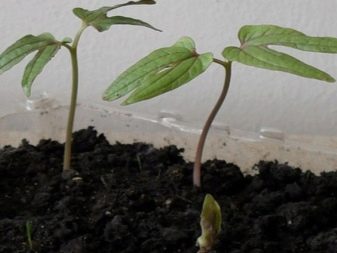
The seeds are deepened into the holes at a distance of 30-40 centimeters from each other. 3–8 seeds are dipped into one hole. Under favorable conditions, the first shoots will appear in 2-3 weeks.
How to plant seedlings?
You can grow a liana in a seedling way. For this, the seeds are deepened into special peat pots, the optimal time for this work will be the beginning of March. Before this, the seeds are best kept in water for a while. It is worth not more than one centimeter to deepen the planting material into the ground, then the seeds must be watered and covered with polyethylene or glass.
Crops should be germinated in a well-lit room at a temperature not lower than +20 С... After the appearance of a couple of the first leaves, young plants need to be picked and planted in separate pots along with an earthen lump. It is best to plant a vine in open ground already in May, when the weather is warm outside.

How to care?
After planting, a flowering culture will need competent care from a gardener. It is important to ensure that quamoklite does not grow in the shade, since during the development and formation of the crown - in spring and summer - some garden crops can create excessive shade for the plant. In the shade, the vine will lose its ability to bloom. Kvamoklit will indicate an overabundance of the sunny color of morning glory with closed buds even in the daytime.
Some growers prefer to cultivate quamoklite as a perennial indoors, growing it as an ampelous plant.
In order for the vine to please its owner with long flowering, it needs to provide good hydration. As the experience of growing a tropical crop shows, the size and brightness of the color of the buds will directly depend on the quantity and quality of irrigation. It is recommended to give the plant a lot of moisture, however, it is still worth turning the soil under the crop into a swamp.
In the process of vines rooting in the garden, the location of groundwater should also be determined - since the roots of the vines can go deep underground, excess moisture in the soil can provoke the development of rot on the rhizome.

It is best to moisten the culture in the summer 2-3 times a week, to water the vines, it is worth using warm melt water, avoiding too much difference in the temperature of the soil and the introduced liquid. As a rule, one adult liana will require about one liter of water per watering.
A flowering plant develops better with additional feeding - for these purposes it is worth using complex mineral-based formulations, the optimal fertilization schedule will be 1 time in 7 days in the phase of active vegetative growth and development.


The culture can be attacked by insects. The most dangerous individuals include the spider mite. To avoid the appearance of such pests on the plant, gardeners should regularly arrange preventive spraying of the aboveground part of the kvamoklite with cold water. The insect multiplies very quickly and destroys the culture, so regular inspection and spraying will help save the vine from death. If a silvery cobweb is found on a green mass, it is worth using store-bought insecticides to destroy the pest colony.

When aphids appear, the foliage of the plant will be covered with yellow spots. The fight against such a pest is carried out by spraying the aerial part of the vine with an ash and soap solution. With a large number of insects, as well as a strong damage to the culture, the gardener will need to process the kvamoklite with store-bought chemicals.


Due to errors regarding excessive watering, morning glory kvamoklit can be affected by fungal and viral ailments. For the treatment of the culture, it is recommended to remove the affected parts of the vine, followed by the treatment of the plant with antifungal drugs. Root rot cannot be cured, so such a vine is removed, and the soil is disinfected.
An important component of care is the creation of supports for the correct development of shoots and landscaping of the territory.... To maintain external attractiveness and decorativeness, you can trim the kvamoklite, however, in most cases, the culture independently creates a beautiful crown that braids any support nearby.
It is recommended to transplant the plant only as a last resort, since all varieties of flowering creepers experience great stress after a change of location, and also begin to hurt, which will negatively affect the appearance of the plant.


For tips on caring for and growing morning glory, see the following video.


































































































The comment was sent successfully.